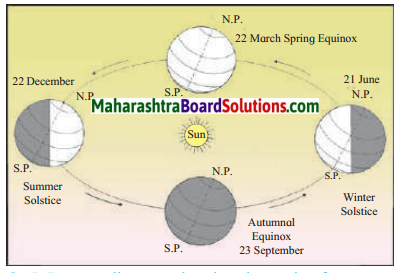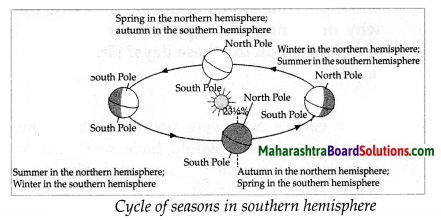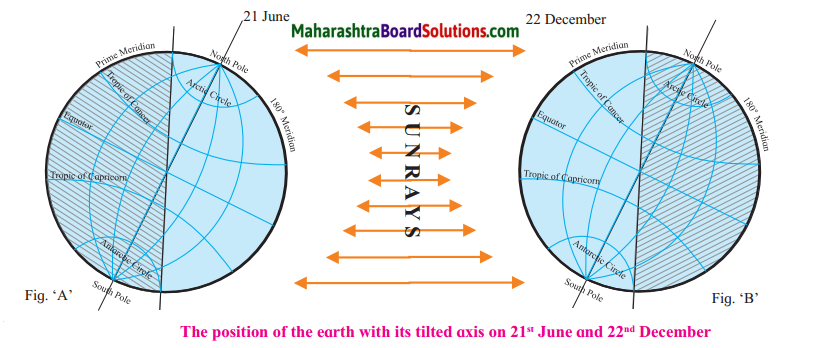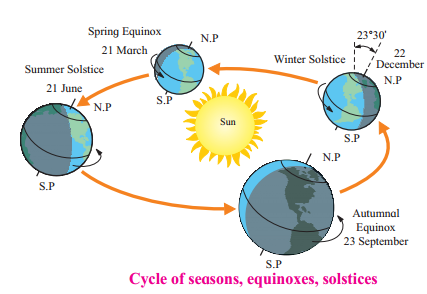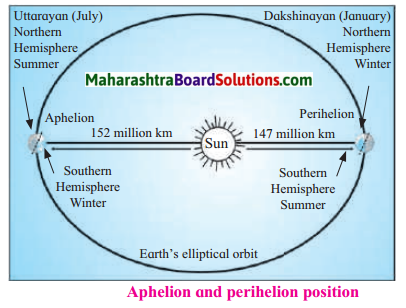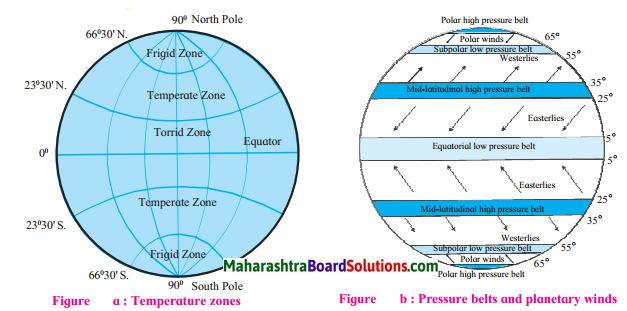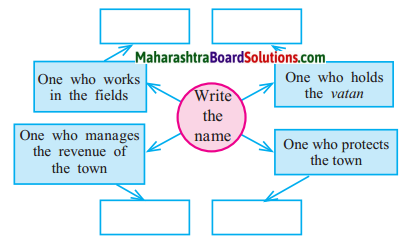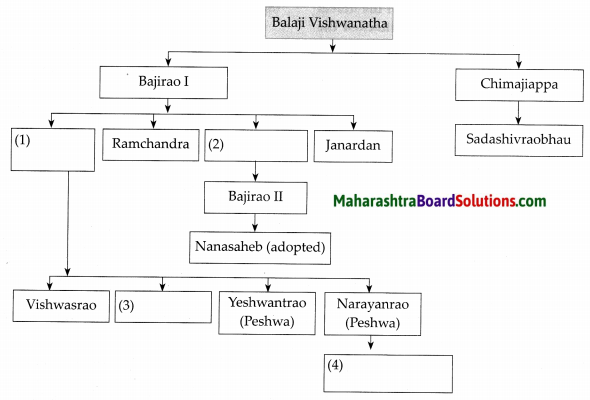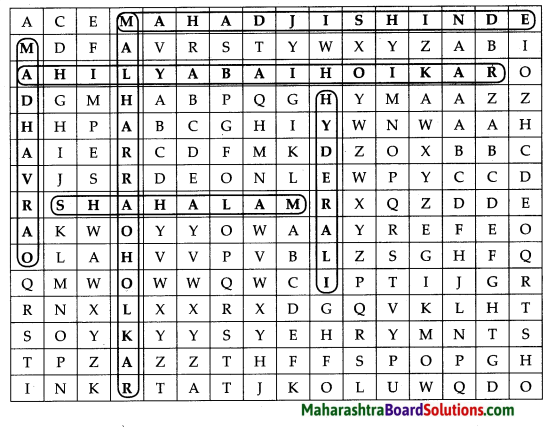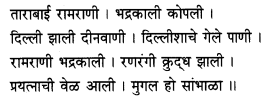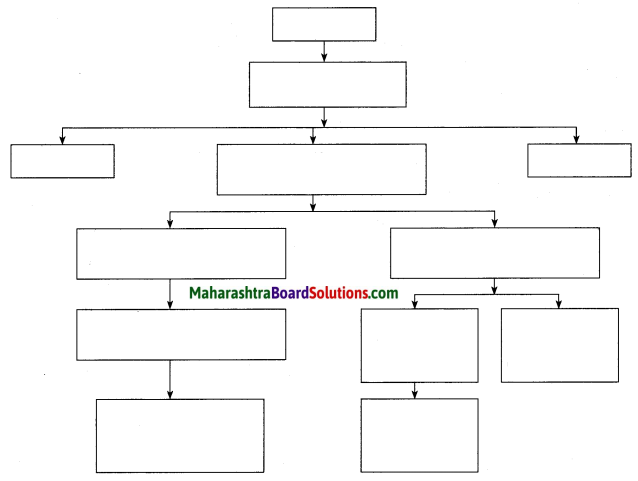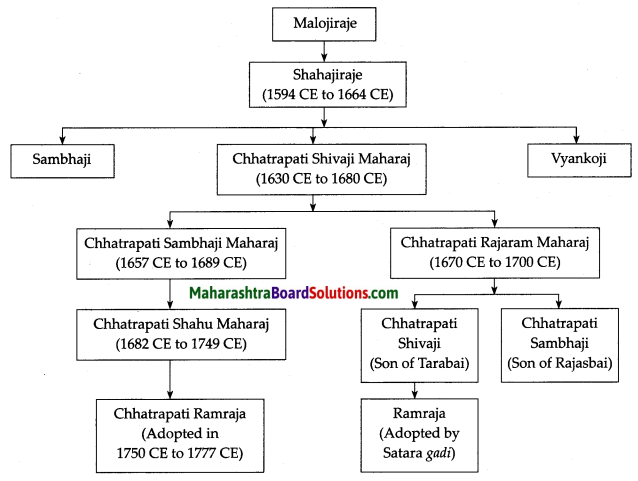Balbharti Maharashtra State Board Class 7 Geography Solutions Chapter 9 Agriculture Notes, Textbook Exercise Important Questions and Answers.
Std 7 Geography Chapter 9 Question Answer Agriculture Maharashtra Board
Class 7 Geography Chapter 9 Agriculture Question Answer Maharashtra Board
Agriculture Class 7 Questions And Answers
1. Select the proper option for the following statements:
Question 1.
In which of the following type of farming
are the crops rotated?
(a) Intensive.
(c) Commercial.
(b) Plantation.
(d) All of these.
Answer:
(a) Intensive.

Question 2.
Agriculture requires the following:
(a) Only ploughing
(b) Use of animals, implements, machines and manpower.
(c) Use of only manpower.
(d) Just cultivate the crop.
Answer:
(b) Use of animals, implements, machines and manpower.
Question 3.
In India, agriculture has developed because…
(a) There are two seasons of agriculture in India.
(b) Majority of the people depend on agriculture.
(c) Traditional agriculture is practised in India.
(d) In India factors like climate, soils, water, etc. are conducive.
Answer:
(d) In India factors like climate, soils, water, etc. are conducive.
Question 4.
It is necessary that modern methods and technology be used in agriculture in India because…
(a) There are factories producing improved seeds.
(b) There are industries producing fertilizers
(c) Population is growing and there are agro-based industries.
(d) Modern means and machines are available.
Answer:
(c) Population is growing and there are agro-based industries.
2. Give short answers for the following questions:
Question 1.
Describe the importance of irrigation for agriculture.
Answer:
(i) Irrigation means the process of supplying of water through artificial means such as pipes, canals, sprinklers, etc.
(ii) Irrigation helps the farmers to be less dependent on rain water for the purpose of agriculture.
(iii) Since monsoons are uncertain & highly variable, farming cannot entirely depend upon rains
(iv) Hence irrigation is needed to grow assured crops & also to grow crops in the months after the monsoon season.

Question 2.
Distinguish between intensive farming & shifting cultivation.
Answer:
| intensive farming |
Shifting Cultivation |
(i) Intensive farming is carried out in one and the same farm for years together.
(ii) This type of farming is mostly seen in the developing regions.
(iii) In this type of farming the cultivator and his family are totally dependent on farming. Farm production is sufficient only for the requirement of the family. |
(i) In shifting Cultivation, every year a new area is chosen for cultivation.
(ii) This type of cultivation is practised in the tropics in densely forested areas or hilly tracts.
(iii) The production obtained from shifting cultivation is not sufficient to fulfill the food requirement. So people undertake hunting, fishing and gathering of bulbs and roots from forest. |
Question 3.
Mention the major types of farming and give information about intensive farming and extensive grain farming?
Answer:
Broadly the following types of farming are identified

Intensive farming:
- Intensive farming is a type of traditional farming. It is carried out in one and the same farm for years together.
- Getting maximum production from a minimum area is the characteristic of Intensive farming.
- Due to large population or limited availability of land, per head holding is small.
- This type of farming is mostly seen in developing region.
- The cultivator and his family are totally dependent on farming. The farm production is sufficient only for the requirements of the cultivators family.
- As farm production is low hence the economic condition of the cultivator is also poor.
Extensive farming:
- Extensive grain farming is a type of commercial farming.
- Farm size is greater than 200 hectares.
- Due to large farm size and sparse population in the region, this type of farming is carried out with the help of machines like tractors and crushers.
- Helicopters or planes are used for spraying pesticides.
- Mono crop cultivation is the main characteristic.
- Crops like wheat, corn, barley, oats, soyabean are cultivated.
- Heavy capital investment is necessary. Since huge expenditures are needed for purchase of machinery, fertilisers, pesticides, godowns, transport cost, etc.
- Droughts, attack by pests, locusts, market fluctuation, etc. are the problems in extensive grain farming.
- This type of farming is carried out in the temperate grassland regions.

Question 4.
Describe the characteristics of plantation farming.
Answer:
(i) Plantation farming is a type of commercial farming.
(ii) Farm size is 40 hectares or above.
(iii) As plantation agriculture is practised in hilly tracts of tropical regions, use of machines are not possible hence local manpower is used.
(iv) This is a single crop cultivation practice.
(v) Only commercial crops like tea, rubber, coffee, coconut, cocoa, spices, etc. are planted.
(vi) This type of farming requires large scale capital investment.
(vii) Major issues faced are climate, manpower, deterioration of environment, economic and managerial problems.
(viii) Plantation farming is practised in India and other South Asian countries, Africa, South and Central America.
Question 5.
Which are the crops cultivated in your area? What are the geographical reasons for that?
Answer:
(i) I live in the konkan region of the state of Maharashtra
(ii) The main crops cultivated in our area are mangoes, rice, coconut, cashew, etc.
(iii) Konkan region has hot & humid climate, heavy rainfall which favours the growth of these crops.
(iv) This region has fertile laterite soil which is suitable for cultivation of fruits.
Question 6.
Why is the agriculture in India seasonal in nature? What are the difficulties for perennial agriculture?
Answer:
(i) Most of the agriculture in India is dependent on monsoon rainfall. 80% of the rainfall in India is received from south west monsoon winds from June to September.
(ii) Since monsoon in India is seasonal; agriculture in India is also seasonal in nature.
Difficulties for perennial agriculture
(i) Rainfall in India is highly irregular & uncertain. Also there is lack of irrigation facilities.
(ii) There is lack of capital investment, godowns, transportation, etc.
(iii) There is lack of awareness with respect to scientific methods of crop cultivation.
Activity:
Visit a farm where modern technology is used for agriculture. Collect information about it.
Use of ICT
Question 1.
Collect the pictures of improved seeds and means of irrigation from the internet.
Question 2.
Collect information regarding agricultural in Israel from the internet. and present it.
Class 7 Geography Chapter 9 Agriculture InText Questions and Answers
Can you tell?
Observe the picture and briefly describe the type of agriculture shown.
Question 1.
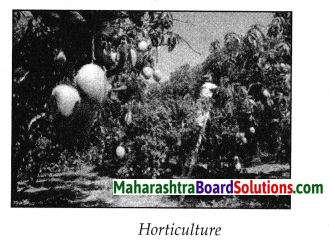
Answer:
(a) For the growth of fruits a large number of similar trees are grown in a vast area. Such land areas are called farms or orchards, for e.g. mango, coconut.
(b) In this type of farming modern as well as traditional methods are used.
(c) Use of irrigation, chemical fertilizers, green houses, etc. is being made for getting more profit.
Question 2.

Answer:
(a) One single crop is grown in a large area.
(b) The use of man power is less, whereas most of the farmwork is done with the help of machines like tractors, harvesters, threshers, etc.
(c) Heavy capital investment is necessary for this type of farming.
Question 3.
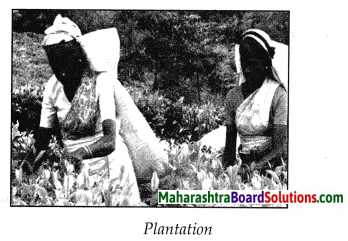
Answer:
(a) One single tree crop is grown on a large scale.
(b) Only commercial crops like tea, rubber, coffee, cocoa, coconut, spices, etc. are planted.
(c) It requires lot of capital investment due to the long duration of crops, use of scientific methods, exportable production, processing,

Question 4.
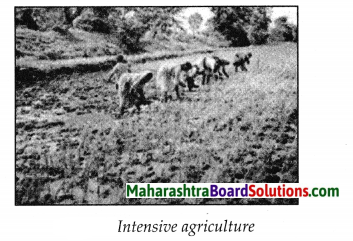
Answer:
(a) Crops are grown on small farm lands with the help of bovine (animal) and human resources.
(b) The profits earned are very low despite intensive care taken.
(c) The crops that are grown are used for home consumption and the excess, if any, is sold in the local market.
Observe the picture and answer:
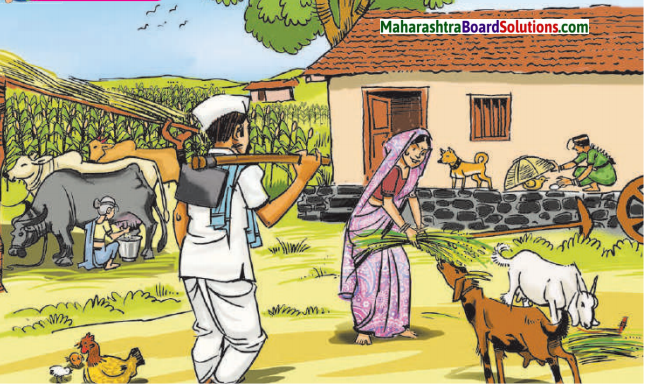
Question 1.
What all do you see in the picture?
Answer:
A farmer’s house, a farmer keeps cows, hens, sheep, goats and cattle, a standing crop, a plough share, farmers wife grazing the cattle.
Question 2.
Why has the family kept goats and hens?
Answer:
Farmer gets milk from goats and eggs from the hens.
Question 3.
Which implements are seen in the picture?
Answer:
The spade and plough are seen in the picture
Question 4.
How are these implements used?
Answer:
Spade is a hand tool used to dig or loosen ground or break lumps in the soil. A plough is used for ploughing the fields. Ploughing turns organic matter into soil to increase decomposition and add nutrients from organic matter to the soil.

Question 5.
In which major occupation type will the activities shown here be included?
Answer:
The activities shown in the picture mostly fall under the occupation of agriculture.
Question 6.
What could be the main occupation of these people?
Answer:
The main occupation of these people could be cultivation of crops.
Question 7.
Who could be the owner of the house?
Answer:
The farmer himself could be the owner of the house.
Question 8.
Which products shown in the above picture do you use?
Answer:
Milk and dairy products, eggs are used in our day to day lives.
Give it a try:
Observe the pictures and answer the following questions.
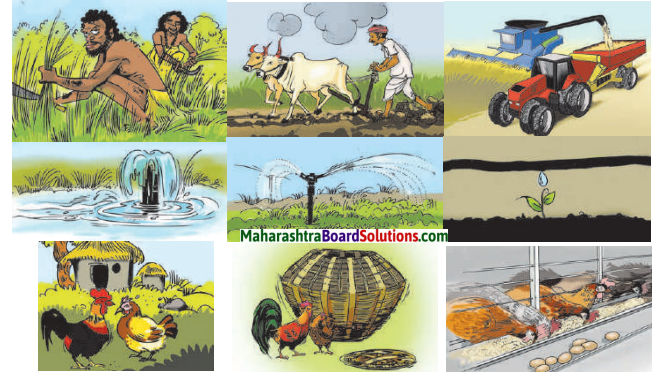
Question 1.
What differences do you observe these pictures?
Answer:
In the pictures we can observe the changes in agricultural practices. It shows the transition from traditional to modern agriculture.
(a) Initially man cultivated crops using only manual labour. Later he started using various animals like bullocks to cultivate crops.
Today we use modern machines for various agricultural practices.
(b) Irrigation too has changed – from water allowed to flow freely in the field though pipes, man now uses modern methods like sprinkler & drip irrigation.
(c) Poultry farming is supplementary to cultivation of crops & is included in agriculture. Initially hens were reared in small numbers in open areas. But today hens are reared on a large scale. With use of modem techniques it leads to large scale production of eggs.
Question 2.
What changes have taken place in traditional agricultural practices?
Answer:
Traditionally agriculture was carried out using manual labour & bovine power. Today modem methods of agriculture include using machines tractors, harvests, fertilizers, insecticides, pesticides, etc. for better yield of crop.
Irrigation is used for ample water supply throughout the year to maximize crop production. Modern, scientific techniques & use of hybrid seed, leads to more productivity of land, (more crop production in limited land area)

Answer the following questions:
Question 1.
Which improper practices arising out of man’s greed are observed in agriculture.
Answer:
In order to produce the fruits and vegetables early and sell them quickly, man uses artificial chemical, which harms the soil & hampers the quality of production.
Question 2.
What means of irrigation are available in your area?
Answer:
(a) Drip and Sprinkler irrigation is used in many orchards across the konkan region of Maharashtra.
(b) Wells & tube wells are other methods used on large scale.
Question 3.
Have you observed the wastage of water in agriculture? If yes, describe it.
Answer:
There was a field in my native place. The farmer would water the field leaving the water pipe on the field. Lot of water would be wasted. But now the same farmer waters the field using sprinkler irrigation method. As a result there is no wastage of water, any more.
Question 4.
Which steps can easily be taken to avoid improper practices in agriculture?
Answer:
(a) System of Agricultural Produce Market committee should be established at taluka level and farmers should be encouraged to bring their produce and sell to the traders here
(b) As farm produce is perishable, there has to be a proper arrangement for its sale to avoid,wastage.
(c) Institutes like farmer’s organizations, consumer societies, etc. help and try to protect farmers from exploitation by agents, mediators and others.
(d) Farmers should not use artificial chemicals and pesticides.
Use your brainpower:
Question 1.
Why does extensive commercial farming need more capital?
Answer:
(a) Farm size is greater than 200 hectares.
(b) Due to large farm size and sparse population in the region, this type of farming is carried out with the help of machines like tractors and crushers.
(c) Pesticides are sprayed with the help of helicopters or planes.
(d) Since huge expenditures are needed for the purchase of machinery, fertilizers, pesticides, godowns, transport cost, etc. So extensive commercial farming needs more capital.
Question 2.
Why does plantation farming need skilled and experienced labour?
Answer:
(a) Farm size in plantation farming is 40 hectares or above.
(b) Plantation farming is practised in hilly tracts, so use of machines is not possible.
Hence, plantation farming needs skilled and experienced labour.
Question 3.
In what different ways is ground water obtained for agriculture?
Answer:
(a) Ground water is the water that is found underground.
(b) When it rains, about 20% of the rain water seeps into the ground, forming a water table.
(c) A well as deep as the water table is dug, in order for it to pump water to the fields for agriculture.
(d) Now days use of tube wells have become popular too

Class 7 Geography Chapter 9 Agriculture Additional Important Questions and Answers
Fill in the blanks choosing the correct options from the bracket:
Question 1.
Commercial dairy fanning is mainly undertaken for _________. (milk and fish, meat and milk, meat and poultry)
Answer:
meat and milk
Question 2.
Sheep rearing is carried out to obtain ________. (cotton, silk, wool)
Answer:
wool
Question 3.
In order to achieve the best growth of fish, ________ methods are employed. (pisciculture, scientific, electronic)
Answer:
scientific
Question 4.
Silk thread is obtained from the ______ of the silk moth. (cocoon, mulberry, skin)
Answer:
cocoon
Question 5.
Leaves of the ______ trees are the main food for the silk worms. (mulberry, pepal, coconut)
Answer:
mulberry
Question 6.
______ farming is a highly specialized type of farming of the modem era. (Intensive, Subsistence, Modern)
Answer:
Greenhouse
Question 7.
Intensive farming and shifting cultivation are the two types in ______ farming. (extensive, traditional, intensive)
Answer:
traditional
Question 8.
Shifting cultivation is a ________ type of cultivation, (primitive, extensive, intensive)
Answer:
primitive
Question 9.
Cultivation of flowers and fruits is a subtype of _______ gardening. (market, organic, plantation)
Answer:
market
Fill in the blanks:
Question 1.
_______ is a new field of tourism.
Answer:
Agrotourism
Question 2.
Most of the farmers are ________ weak and cannot market their product on their own.
Answer:
economically
Question 3.
As farm produce is ______ there has to be a proper arrangement for its sale.
Answer:
perishable

Question 4.
Some of the farm produce is directly used by industries as ______.
Answer:
raw material
Question 5.
_____ is a major exporter of fresh farm produce.
Answer:
Israel
Question 6.
International markets are now becoming easily available for farm produce due to _____.
Answer:
globalization
Question 7.
France and Italy are famous for ________.
Answer:
horticulture
Question 8.
____ is obtained from organic waste.
Answer:
Vermicompost
Select the proper option for the following statements:
Question 1.
Heavy capital investment is necessary for
(a) Subsistence farming
(b) Extensive grain farming
(c) Shifting cultivation
(d) Dairy farming
Answer:
(b) Extensive grain farming
Question 2.
Getting maximum production from a minimum area is the characteristic of
(a) Plantation farming
(b) Intensive farming
(c) Horticulture
(d) Extensive grain farming
Answer:
(b) Intensive farming
Complete the following sentence:
Question 1.
For our basic needs of food and clothing ______.
Answer:
we make use of plants and animals
Question 2.
In agricultural occupation, resources like _______.
Answer:
manpower, animals, implements, etc. are used

Question 3.
In the past primitive man had to wander in the forest to ______.
Answer:
sustain himself on the collected forest produce
Question 4.
Bees in order to collect honey, _______.
Answer:
hover around the plants that bear flowers
Question 5.
Silk thread is obtained from the _________.
Answer:
cocoon of the silk moth
Question 6.
Greenhouse farming facilitates _______.
Answer:
getting maximum product from the land
Question 7.
Greenhouse farming is ________.
Answer:
highly specialized type of farming of the modern era
Question 8.
Different types of agriculture has evolved due to _______.
Answer:
geographical and cultural diversity and technological differences in different regions
Question 9.
Intensive farming is carried out in ________.
Answer:
one and the same farm for years together
Question 10.
In shifting cultivation, ________.
Answer:
every year a new area is chosen for cultivation
Question 11.
The problems in extensive grain farming are ______.
Answer:
droughts, attacks by pests, locusts, etc. and also market fluctuation
Question 12.
Market gardening has developed mainly as a _______.
Answer:
result of urbanization and the ready markets available in urban centres
Question 13.
Cultivation of flowers and fruits is a ________.
Answer:
subtype of market gardening

Question 14.
As farm produce is perishable, _________.
Answer:
there has to be a proper arrangement for its sale
Question 15.
Most of the farmers are ______.
Answer:
economically weak and cannot market their production on their own.
Question 16.
By advertising on the internet, ______.
Answer:
the agricultural products get sold in local as well as international markets
Answer in one sentence:
Question 1.
What do we depend on for our basic needs of food and clothing?
Answer:
For our basic needs of food and clothing, we make use of plants and animals.
Question 2.
What is considered to be the main and the most important occupation in agriculture?
Answer:
In agriculture, cultivation of crops is considered to be the main and the most important occupation.
Question 3.
Why had the primitive man to wander in the forest in the past?
Answer:
Primitive man had to wander in the forest to sustain himself on the collected forest produce.
Question 4.
What is the core of animal husbandry?
Answer:
Rearing different animals and obtaining various products from them for subsistence is the core of animal husbandry.
Question 5.
On what do sheep and goats survive?
Answer:
Sheep and goats survive on short grass, shrubs and acacia, grown in remote hilly areas away from urban settlements.
Question 6.
What do we obtain from Beekeeping occupation?
Answer:
We obtain honey and wax from Beekeeping.
Question 7.
What is Pisciculture?
Answer:
Pisciculture is also called fish farming in which fish seeds are released in the pond to achieve the best growth of fish.

Question 8.
Name the fish reared in fish farms.
Answer:
Warn, Roha, Rawas, Kolambi are reared in fish farms.
Question 9.
What is used to weave soft silk cloth?
Answer:
Fine and strong silk thread obtained from the cocoon of the silk moth are used to weave soft silk cloth.
Question 10.
Which is the highly specialized type of farming of the modem era?
Answer:
Greenhouse farming is a highly specialized type of farming of the modem era.
Question 11.
Which are the two types in traditional farming?
Answer:
Intensive farming and shifting cultivation are the two types in traditional farming.
Question 12.
What is the characteristic of intensive farming?
Answer:
Getting maximum production from a minimum area of land is the characteristic of intensive farming.
Question 13.
Where is shifting cultivation practised?
Answer:
Shifting cultivation is practised in the tropics in densely forested areas or hilly tracts.
Question 14.
Name the two major types of farming covered under commercial farming.
Answer:
Extensive grain farming and plantation agriculture are the two major types of farming covered under commercial farming.
Question 15.
What are the problems in extensive grain farming?
Answer:
The problems in extensive grain farming are droughts, attack by pests, locusts, etc. and market fluctuations.
Question 16.
What are the major issues faced by the plantation farming?
Answer:
Climate, manpower, deterioration of environment, economic and managerial problems are the major issues faced by the plantation farming.
Question 17.
Where is plantation farming practised?
Answer:
Plantation farming is practised in India and other South Asian countries, Africa, South and Central America, etc.
Question 18.
What is a subtype of market gardening?
Answer:
Cultivation of flowers and fruits is a subtype of market gardening.
Question 19.
What are the major products of horticulture?
Answer:
Major products of horticulture are flowers like lily, gerbera, tulip, dahlia, chrysanthemum, marigold, etc.

Question 20.
Name some native and exotic fruits cultivated in fruit farming.
Answer:
Different native and exotic fruits like mangoes, custard apples, grapes, bananas, pomegranates, dragon fruits, cherries, oranges, strawberries, raspberries, etc.
Question 21.
What is organic farming?
Answer:
When farming is done using all vestal matter mixed in the soil, it is called organic farming.
Question 22.
Why do city dwellers visit the rural areas?
Answer:
City dwellers are curious about the farmers life and environment so they visit the rural areas to see the rural life, local customs and culture.
Question 23.
Why are some fruits and vegetables harmful to health?
Answer:
Some fruits and vegetables may have been produced using artificial chemicals, and pesticides for quicker production. Such fruits and vegetables are harmful to health.
Give geographical reasons:
Question 1.
The system of Agricultural Produce Market Committees is established at the Taluka level.
Answer:
- Most of the farmers are economically weak.
- These farmers cannot market their production on their own.
- At these places, farmers bring their produce and sell to the traders.
- Hence, the system of Agricultural produce market committee is established at taluka level.
Question 2.
Poultry occupation is generally located in big cities.
Answer:
- Running a poultry on commercial basis requires a lot of care.
- For this scientific methods are employed.
- Areas in big cities provide a ready market for this occupation.
- Hence poultry occupation is generally located in big cities.

Question 3.
Bee keeping is an important occupation with respect to agriculture.
Answer:
- Beekeeping occupation is undertaken to obtain honey and wax.
- In order to collect honey, bees hover around the plants that bear flowers.
- This promotes the process of pollination .
- Pollination helps the trees to bear large number of fruits and increase the yield of crops. Hence, Bee keeping is an important occupation with respect to agriculture.
Question 4.
Specific type of fish species are reared separately.
Answer:
- During fishing, different types of fish and other aquatic organisms get caught in the fishing nets.
- Separating them becomes a major task.
- All organisms do not fetch the same price. Due to the above factors specific type of fish species are reared separately.
Question 5.
The expenditure of planting mulberry trees every year is saved.
Answer:
- Leaves of mulberry trees are the main food for the silk worms.
- Once planted, the mulberry trees survive for a minimum period of 15 years.
- Hence, the expenditure of planting mulberry trees every year is saved.
Question 6.
Last few years, has seen the development of nurseries.
Answer:
- In the last few years, the area under floriculture cultivation of medicinal and aromatic plants and horticulture has increased.
- These plantations require a high standard of seedlings, cuttings, bulbs and seeds.
- Nurseries give good returns.
- This has led to the development of nurseries.
Question 7.
Heavy capital investment is necessary for extensive grain fanning.
Answer:
- Extensive grain farming Is carried out with the help of machines like tractors and crushers.
- Pesticides are sprayed with the help of helicopters or planes.
- Huge expenditures are needed for the purchase of machinery, fertilizers, pesticides, godowns, transport cost, etc.
- So heavy capital investment is necessary for extensive grain farming.
Question 8.
Market gardening is also known as truck farming.
Answer:
(i) Market gardening has developed as a result of urbanization and the ready markets available in urban centres.
(ii) Farmers cultivate vegetables and other items in the vicinity of urban centres to cater to the demands of city dwellers.
(iii) Market gardening is dependent on good transport network.
(iv) The quality and price of the product is determined by rapid transport. Hence, market gardening is also known as ‘truck farming’.

Question 9.
Agrotourism is financially beneficial for the farmer and his village.
Answer:
- Agrotourism is a new field in tourism.
- In the tropics, various types of agricultural products are cultivated.
- City dwellers are curious about the farmer’s life and environment.
- Many of the city dwellers visit the rural areas to see this. So, Agrotourism is financially beneficial for the farmer and his village.
Question 10.
In intensive farming the economic condition of the cultivator is poor.
Answer:
- Intensive farming is practised in areas of high population.
- Due to large population per head holding is small.
- Because of small land holding & traditional methods of cultivation farm production is sufficient only for the requirement of the family.
- As the farm production is low, the economic conditions of the cultivator is poor.
Question 11.
How do farmers grow their crops?
Answer:
- After deciding what to grow, farmers often till the land by loosening the soil.
- The soil is then mixed with fertilizers.
- Then they sow seeds or plant seedlings.
- When the crops are growing farmer must water the seed and kill crop pests.
Write short notes on:
Question 1.
Greenhouse farming:
Answer:
(i) Greenhouse farming is a highly specialized type of farming of the modem era.
(ii) For erecting a greenhouse galvanized iron pipes and plastic sheets are used. It can have total control on natural factors like climate, heat, atmospheric moisture as well as soil moisture.
(iii) Its main aim is to control pest attack by controlling water, light & temperature.
(iv) Green house farming facilitates getting maximum product from land. It assists in getting maximum economic benefit
(e) Greenhouses are used on large scale for growing flowers like lily & gerbera to igive maximum returns.
Question 2.
Market gardening:
Answer:
(i) Market gardening is a type of cultivation developed mainly as a result of urbanization & ready markets available in urban centres.
(ii) Farmers cultivate vegetables & other items in the vicinity1 of urban centres to cater to the demands of city dwellers.
(iii) The landholding is small. Use of irrigation, organic & chemical fertilizers, low investment, use of manpower, demand of markets, use of science & technology are the characteristics of market gardening.
(iv) It is dependent on good transport network. The quality & price of the product is determined by rapid transport. Hence this type of farming is also called truck farming.

Question 3.
Organic farming:
Answer:
(i) The nutrient requirements of the crops is fulfilled by soil & therefore replenishment of used up nutrients is necessary.
(ii) Nutrients are also used abundantly to increase the yield. Organic fertilizers are prepared for this purpose
(iii) The litter should be decomposed in the ground. Grass like resbania or jute are also buried in the soil for making manures Cowdung & compost manures are used. Vermicompost is obtained from organic waste.
(iv) When farming is done using all the vestal matter mixed in the soil it is called organic farming
(v) The crop obtained from organic farming is high in quality.
Question 4.
Agrotourism:
Answer:
- Agrotourism is a new field in tourism.
- Vicinity – the area near or surrounding a particular place.
- In the tropics various types of agricultural products are cultivated. Hence there is greater scope for agrotourism.
- In agrarian countries the rural life, local customs & culture are utilized for agrotourism.
- City dwellers are curious about the farmers’ life & environment and many of them visit rural areas just to see this.
- Agrotourism is financially beneficial for the farmer & his village.
Question 5.
Importance of marketing system in India:
Answer:
The following points explain the importance of marketing systems in countries like India:
- Agriculture in India is scattered over vast areas.
- All farmers are not organized.
- Most of the farmers are economically weak & cannot market their production on their own.
- As farm produce is perishable, there has to be a proper arrangement for its sale.
Question 6.
Beekeeping.
Answer:
- Beekeeping is an important occupation with respect to agriculture
- It is undertaken to obtain honey & wax. In order to collect honey, bees hover around the plants that bear flowers.
- This promotes the process of pollination.
- As a result, the trees bear large number of fruits & the crop yields increase.
Question 7.
Pisciculture or Fish farming:
Answer:
- Farm ponds are dug out for the purpose of pisciculture. Water is stored in such ponds.
- Fish seeds are released in the ponds. For this seeds of fresh water species are used.
- In order to achieve the best growth of fish, scientific methods are employed.

Question 8.
Give comparative account of any two methods of irrigation
Answer:
Well irrigation, canal irrigation, drip & sprinkler irrigation, tank irrigation etc. are various methods of irrigation. Wells & canals have been used for irrigation since ancient times.
Well irrigation:-
- In this type of irrigation, a well is dug in the ground from which ground water is taken out for irrigation,
- The area required for digging wells is less,
- It is a cheap, dependable & popular method of irrigation in India.
Canal irrigation:-
- In this type of irrigation, dams are constructed on rivers & water of the river is stored in the reservoir,
- The stored water is then supplied to fields with the help of canals,
- Canal irrigation requires vast area for construction of dam as well as constructing network of canals,
- Canal irrigation is dependable but costly method of irrigation.
Question 9.
Sericulture:
Answer:
- Rearing of silkworm in order to obtain silk is sericulture.
- Leaves of the mulberry trees are the main food for these silk worms.
- Once planted the mulberry trees survive for a minimum period of 15 years.
- Silk thread is obtained from the cocoon of the silk. These threads are very fine & strong. They are used to weave silk cloth.
7th Std Geography Questions And Answers:

![]()
![]()
![]()
![]()
![]()
![]()
![]()
![]()
![]()







